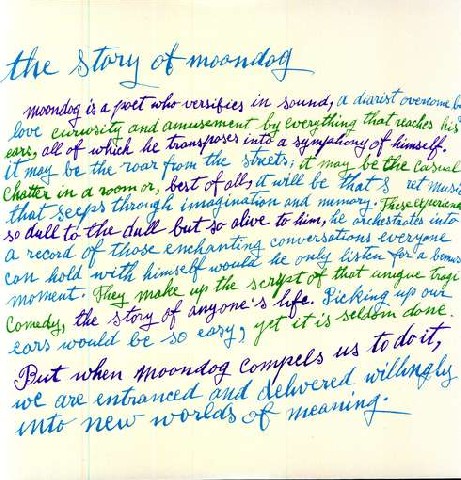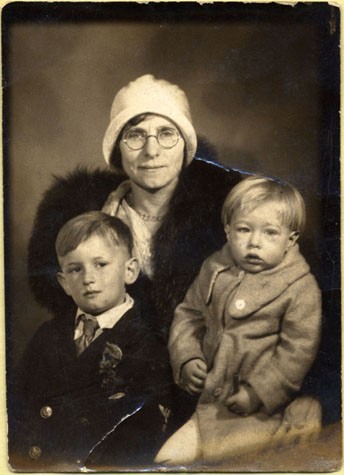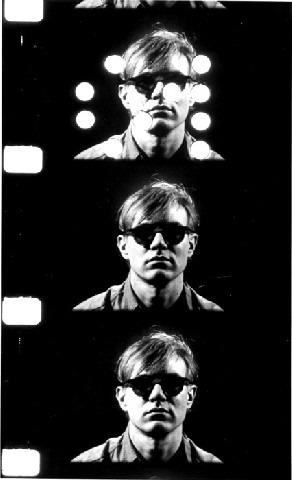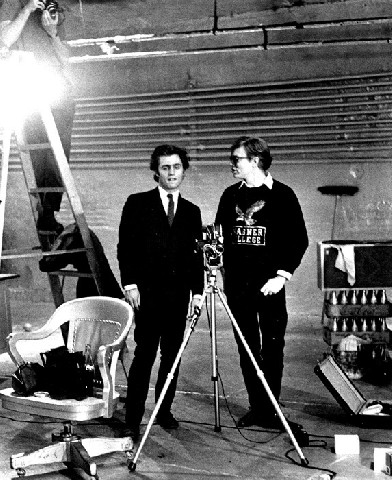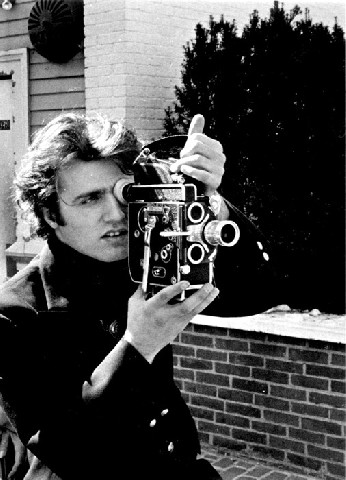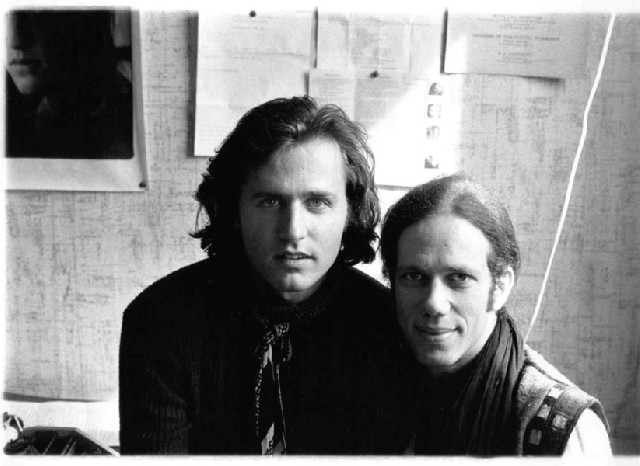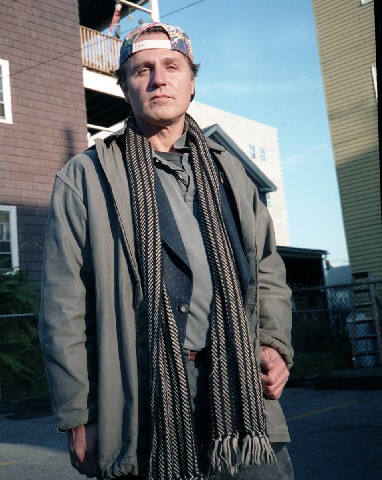Gerard Malanga on Andy Warhol's Mother Julia
Insights to Mother and Son Collaborations at WCMA
By: Charles Giuliano - Jun 04, 2015
The major exhibition this summer at the Williams College Museum of Art is "Warhol by the Book" through August 16, 2015.
The exhibition which is installed in a series of galleries includes 500 works. Some of the most intriguing material entails collaborations between the artist and his mother Julia. Her unique calligraphy was an integral part of his early graphic style as a book designer and commercial artist.
When Warhol began to enjoy success in New York Julia Warhola left Pittsburgh and lived with him for a number of years.
Previously we interviewed Tina Olsen, the director of WCMA, about the major exhibition of rarely seen material. Wanting to know more about Julia we spoke with former Warhol associate the poet, photographer, and archivist , Gerard Malanga, who knew her well. Starting with a cover story for Art New England some years ago Gerard and I have published and posted a number of dialogues.
Charles Giuliano An important aspect of the book related exhibition at the Williams College Museum of Art is the collaboration between Andy and his mother Julia. It is difficult to find information about her but I am calling because you knew her.
(She was born Júlia Justína Zavacká, November 17, 1892—November 22, 1972, to a peasant family in the Rusyn village of Miková, Austria-Hungary (now in northeast Slovakia) and married Ondrej Varchola (Americanized as Andrew Warhola) there in 1909. He emigrated to the United States soon after, and in 1921 she followed him to Pittsburgh, Pennsylvania. The couple had three children: Paul, John, and Andrew. Her husband died in 1942.
Julia enjoyed singing traditional Rusyn folk songs and loved to draw. Her favorite subjects were angels and cats. She also did embroidery and other crafts. She decorated Easter eggs in the Pysanka tradition.
Julia won awards for her lettering, including one from the American Institute of Graphic Arts for an album cover for The Story of Moondog 1958. In 1957 she illustrated a small book called Holy Cats and she also worked on 25 Cats Name Sam and One Blue Pussy. In 1966, Andy made a movie called Mrs. Warhol (black-and-white, 66 minutes). Andy follows her about with his camera as she goes about her daily domestic routines. In 1971, she returned to Pittsburgh and died a year later.)
Gerard Malanga I knew her very well.
CG Her calligraphy is prominently featured in the exhibition. Apparently she was an artist and the question is to what extent did she influence the youthful Warhol to become an artist.
GM Julia and my mother were very similar in their immediate concerns for their sons. The first instance of that was when Andy and I did the road trip to Los Angeles in December of 1963.
My mother and Julia were on the phone all the time worrying about their sons. (laughs)
You have to understand something about Julia in terms of Andy. He was the youngest of three boys. John was the oldest and I can't remember the name of the second son. At some point they were off, married and raising their families. Julia was left to her lonesome in Pittsburgh. Andy was already in New York beginning to make a success of himself as a commercial artist.
Julia decided that she was going to New York to take care of Andy. That was her conscious decision. Andy welcomed the opportunity. It relieved him of any domestic situations which he wasn't capable of dealing with. When Julia came to New York she basically took care of him. Took care of the household that is.
At first they were living in an apartment in the 30s near Lexington Avenue. Then Andy got a town house at 1342 Lexington. I forget what year that was. I want to say 1960 but I'm not sure.
CG How large was the town house?
GM The situation was that the basement windows were half of the ground floor. It's called a split level basement. There were three more floors above the basement.
CG Did he always live there?
GM It was after I left Andy in the 1970s that he bought a huge town house on East 64th street between Madison and Fifth. That was after Julia passed away.
CG When did you start to work for him?
GM It was the second week in June of 1963.
I remember distinctly that the very first day I went to work for Andy was also the day I met Julia.
It was Tuesday because I met Andy on a Sunday and he wanted me to come to work the very next day. It was preordained that we was going to hire me. He said (mimicking Andy's voice) "Oh when can you come to work for me?" I said "When do you want me to come work for you?' He said "How about tomorrow?" I said "I can't come tomorrow. I'll come on Tuesday." (laughing) I was very brash with him. I told him I had to close out my books at Wagner College.
We met on a Tuesday at noon in front of a building he rented from the City of New York Buildings Department. It was a decommissioned firehouse. I think he rented it for an entire year for a hundred dollars. It was an incredible deal. It was a wreck. There was no electricity. I don't even think it had a toilet. But it was just two blocks from Andy's house.
A classmate from Carnegie Eddie Wallowitch was photographing. The last two pictures that day proved to be very historic. It was me and Andy standing in front of the studio.
CG You were his only assistant at that time.
GM Correct. He hired me because I knew how to make silk screens. He didn't let on but Andy knew my previous employer. There was this guy Leon Hecht who years later, I didn't know at the time, was the boyfriend of Robert Pincus-Witten. Leon was a student of Daisy Aldan at the high school I attended, The High School of Industrial Arts. Leon was a very successful textile artist. He designed men's neck wear for Sun Fabrics. He was designing for Rooster Craft Ties.
CG So you didn't get hired based on your looks.
GM I don't think so. Maybe it was preordained. Charles Henri Ford was the catalyst. He may have put in an extra good word for me.
I went to work for Andy on a Tuesday. When I arrived at the Fire House he was just coming out with Eddie Wallowitch and Barbara Rose who was a graduate student at NYU at the time. Eddie was photographing before I arrived so the last shots he took were of me and Andy. Eddie went off somewhere so Andy, Barbara and I went for lunch at a Greek luncheonette.
She left and Andy and I went back to the Fire House and started to silk screen.
CG What were the images?
GM The first image I worked on that very day was a silver Elizabeth portrait. Then after we got done doing that he showed me what he was doing and I knew exactly what to do. He taught me things here and there but it was basically easy to pick up.
(From an interview Gerard recalled, "He familiarizes me with how he's been working with silkscreens. A simple method, less complicated then when I was screening 30 yards of fabric for a textile firm for four summers. The image - a portrait of Elizabeth Taylor, pink face, red lips, green eye shadow, painted in by hand with liquitex over a hand-painted silver background. The silkscreen is applied, laid down over the abstract color shapes that Andy remarks look like Alex Katz paintings. Black silkscreen paint squeegeed across the entire screen in one motion and then pulled back again. The paint seeps through the tiny openings in the screen. The complete image is registered at last. A painting, simply titled Liz, 1963 (40 x 40 inches), the first of hundreds of paintings we were to silkscreen together.")
After work we walked to his house which is when I met Julia. She looked at me. Then she looked at Andy and back to me. She said "You are Andy's younger brother" and embraced me. I received the blessing. It was like being blessed by the Pope.
Andy was thrilled by the whole thing. Then Julia made lunch so we had a second lunch. She made this concoction a Czechoslovakian hamburger with chopped up onions on a roll with 7 Up.
CG Can you describe her to me? What was her manner?
GM She looked like an elderly babushka. She was an old lady who wore dresses down to her ankles. She wore a scarf sometimes. She had gray hair and wore eyeglasses. She spoke with a fairly prominent broken English accent. With a Slovak accent I should say. She was from the most eastern part of Slovakia which borders on the Ukraine.
CG Did you talk with her?
GM Oh yes. Absolutely. I have an envelope with her signature on it. She just did it as a gesture one day.
CG What kind of conversations would you have with her?
GM Oh, I can't remember too much. There were a number of times we spoke. I was always at the house before we went off to work because that was the gathering place. It was the meeting place.
There was another wonderful man who went to college with Andy and was working for him. I forget his name. He was such a sweetheart. If you research it you can get the name. He died a few years ago. But he was working there. I would say as a ghost artist at the drawing table.
CG Did Andy do silk-screens before you?
GM Yes.
CG Who helped him?
GM He had various people. Friends or whatever but there was nobody steady. Silk-screen can be a very boring process. The physicality of it is very boring. I didn't find it boring. When I was working for Leon it was very creative. I was silk screening 30 yards of pre-stretched fabric. It was then cut up to make the ties. So working with Andy on these silk-screens was a lot of fun.
The people who were working with him would change all the time. He never had anybody steady. He wanted somebody steady to work with him. Those people left because they were bored.
CG Did you ever see Julia making her calligraphy?
GM Except for the one time she wrote something for me, no. Her signature was very much like the calligraphy.
CG So you never saw them work together.
GM No. But Andy gave me as a gift, I should have asked for another sheet, but there was a company where you could go to an art supply store and you could get a pre-printed a whole alphabet and numbers. You could rub them and they would come off.
CG Letraset (was formed to exploit the invention of transfer sheet lettering in 1959.)
GM Correct. Andy had custom made Letraset using Julia's handwriting. I used it for the poster for my poetry reading, at this point I want to say, for my "famous poetry reading" at Leo Castelli Gallery in December, 1964. I used the Letraset that Andy gave me. When you see the Letraset it's all Julia's handwriting. I used it to spell words and the whole thing. I should have gotten an extra sheet to keep as a souvenir.
CG Did Andy use that?
GM He probably did but I can't say for sure. She was there to do calligraphy. She didn't just do calligraphy for Andy. She also did calligraphy for record cover albums. There's a famous record cover for what's his name the blind musician.
CG Stevie Wonder?
GM No, no, before Stevie Wonder. The guy who hung out in front of the CBS building. Looked like a Viking.
CG Moondog. (I presented him in concert when I was director of Spectrum Gallery on 57th Street.)
GM She did an incredible, beautiful actually, Moondog album. It was all her calligraphy. ("The Story of Moondog," Prestige, 1957)
CG She did that herself.
GM Yes, of course. Andy didn't have the talent to make that calligraphy.
CG Did she design it?
GM He probably told her what he wanted her to do. She just did it.
CG Can you describe what you observed of their relationship?
GM Sometimes Andy would lapse into talking Slovak with her. They would communicate bilingually. He probably spoke Slovak fairly well I would say. English was his primary language. There was no reason for him to speak it to anybody else. Except to Julia. In front of me they spoke Slovak.
They had a very simpatico relationship. I saw situations between them that were typical of a mother/ son relationship. He would do something that would make her irritated with him. Andy would start wining like a little boy (imitating voice) "Oh Ma." I don't remember the specific situations. The dynamic or interaction was very interesting.
CG Did he shelter her from the scene? You saw her regularly because you worked for him. Did anyone else come to the house?
GM Oh yeah, sure. I met Henry Geldzahler there. Andy had people visiting at the house. When Andy got the factory on 47th street which was quite a ways from the house, he didn't socialize at the house anymore. All of the socializing took place at The Factory.
CG I thought The Factory was at Union Square.
GM That was the second Factory. The first Factory The Sliver Factory (decorated by Billy Name) was on 47th.
(The original Factory was on the fifth floor at 231 East 47th Street, in Midtown Manhattan. Warhol left in 1968 when the building was scheduled to be torn down to make way for an apartment building. He then relocated his studio to the sixth floor of the Decker Building at 33 Union Square West near the corner of East 16th Street, where it remained until 1973. It moved to 860 Broadway at the north end of Union Square. Although this space was much larger, not much filmmaking took place there. In 1984 Warhol moved his remaining ventures, no longer including filming, to 22 East 33rd Street, a conventional office building.)
A friend of mine had a co-op and owned the rear part of The Factory. When the building went co-op he opted for the rear part of the floor because it was less expensive.
CG Andy had some pretty far out friends. How did Julia interact with them.
GM I can't say that he sheltered her but she spent most of her time in the basement. There as a kitchen and I think her bedroom was there also. Andy's bedroom was on the top floor. When people came to the house occasionally they would meet Julia.
CG In any sense did she seem to enjoy his fame and celebrity?
GB Julia was a very simple woman. She was not in total awe of her son. She knew he was talented. Because of her deficiencies with English she would always talk in the present tense. I remember distinctly because I put it in one of my chapters of my memoirs that she said, I'm paraphrasing, but she said I'm saving all my money to send Andy to college. As opposed to saying I wanted to send Andy to college. It was very clear in her mind that was what she wanted to do. Of the three boys she had Andy showed the talent.
CG The speculation now is that Julia was a sophisticated artist in her own way.
GB Welllll, yes. But a notch above outsider art.
CG Her calligraphy was unique.
GM Her calligraphy was very unique.
CG I believe she also did sketching or drawing perhaps a bit of painting. So the question is to what extent did Julia influence Andy in his decision to be an artist?
GM When Andy was a child he was a drawer. That's another thing we had in common. As kids we drew. Andy could copy but I drew from memory. I had a very good memory for detail. We both came out of that working class milieu of being drawers. I wish I still had my drawings. Teachers were very impressed with what I was doing. There was an encouragement there. Julia was definitely supportive and encouraging of Andy. She saved a lot of his stuff. She saved money and everything went to Andy's education.
CG I take it they were poor.
GM Growing up? Absolutely. Andy's father died when he was a kid. He had black lung disease.
CG Was he working in the coal mines?
GM Andy told me, no Julia actually, that her husband would come home and his white shirt was black.
CG People are fascinated that on Saturday night Andy was on the town but came home to go to church with Mom on Sunday morning.
GM That's not exactly true. It's kind of a myth. If anything Andy made up for not going to church on Sunday. I would go to church with him during the week. When nobody was in the church. There was a church in the Upper East Side, a famous church, I think the archdiocese closed it. Saint Thomas More Church.
(The Church of St. Thomas More is part of a Roman Catholic church complex located on East 89th Street, off Madison Avenue the Upper East Side in Manhattan.)
It was near the Guggenheim Museum actually. We went there a few times. I want to say at 2 or 3 PM. We would sit in a pew for maybe fifteen minutes. (laughing) Then we would leave.
CG Was that a spoof?
GM No, no it wasn't a spoof. It was something we would do occasionally passing by coming from somewhere else. It wasn't a very big church.
CG Do you think it was sincere on his part?
GM Funny but I never gave it any thought. Yeah, I would say it was sincere.
CG In some sense is it fair to say that Andy was genuinely a Catholic?
GM Yes, I think so. I'll give you an example of that. There's an Eastern Orthodox church on the corner of 15th Street and Second Avenue. I think it was built in the late 1950s. Andy gave money to that church because it was the church that Julia used to go to when they were living in an apartment in the 30s.
CG What I find most interesting is that you say Julia came to take care of Andy. One would assume that Andy wanted to take care of her.
GM (laughing) I think it was a two way street. But she had nobody to take care of her. She was by herself.
CG Didn't she go back to Pittsburgh at the end of her life.
GM I wasn't working for Andy at that time so I'm not sure. But that sounds right that she died in Pittsburgh.
(In 1971, she returned to Pittsburgh and died a year later.)
CG To what extent was Julia an anchor in his life? You read about a man who was painfully shy and yet craved fame. He had the duality of inwardness and yet behaved as an extrovert. There is the sense of a delicate balance between public and private.
GM Well, he was living with his mother up on Lexington Avenue. So there is a sense of privacy there of course. That was his house. That's where he lived.
CG When you were in the house you felt comfortable.
GM Oh yeah. For sure. I was accepted by Julia from day one. First of all Andy was a hoarder. It was chockablock with all kinds of stuff. She did put up with that. At some point I think Andy hired a cleaning lady. Julia was basically too old to be doing any kind of cleaning.
I took her down to the hospital when Andy got shot.
CG You did.
GM Absolutely.
I hadn't officially gone back to work for Andy but he was going to give me a check of $50. It was to get a mailer made up for my first movie retrospective at Filmmakers Cinematheque. The day I went to collect the check I was with Angus and Hettie MacLise. The three of us went to The Factory and Andy had already been shot. I want to say within two or three minutes.
There was total pandemonium at The Factory. In Union Square. There was no security when the elevator door opened on that floor. You walked right in. People were running back and forth. Paul (Morrisey) saw me and I said "I'll get Julia. Where's the hospital?"
He told me and shoved some money in my hand (for a cab). I don't know how much it was twenty or forty dollars. I didn't take a taxi. I took the subway uptown. I got there just in the nick of time.
I rang the bell. There were curtains on the door to the house with a big window. It was thin and if you were on the inside you could see through the curtain who was outside. Obviously Julia recognized me and opened the door.
Just as she opened the door, literally, the timing was so incredible, the phone rang and I said to her "Let me get that." I ran up the stairs and got to the phone. Luckily I got to the phone because it was a friend of Julia's from Brooklyn. Calling her because it was already on the news. Radio, television, whatever, that Andy was shot. It's a good thing I got that phone call because it could have turned out to be a very different situation.
At first I lied to her. I gave her the noble lie. I said Andy injured himself in the stomach I have to take you to the hospital. She was not prepared to go anywhere. She had to fix herself. It took her about fifteen minutes to pull everything together. We went outside and she was dressed for winter. (June 3, 1968)
Of course Lexington Avenue is easy to hail a cab and in a couple of minutes we got a taxi. I took her downtown to the hospital. It was on 18th Street off of Third Avenue. I can't remember the name of the hospital.
I brought her into the hospital and introduced her to a doctor or somebody. The lobby was very crowded with people. I explained to the doctor that this was Andy's mother. They said that they would take care of her and escorted her into another room.
CG So you didn't see how she reacted.
GM No.
CG What an amazing story. Of course after Julia passed away when people asked about her Andy's often quoted response was "She's at Bloomingdale's."
GM He co-opted that line. Because I often say to people that when I die I'm going to go shopping at Bloomingdale's. Sometimes I change it to Macy's. I knew the line but I didn't know the context of the line.
CG It was about his mother.
GM (laughing) Oh, it was about his mother, OK.
CG You get the feeling that he didn't deal well with people who passed out of his life. Picasso was also that way.
GM He tried to be campy. He had a very weird sense of humor. When Freddie Herko died he said "He should have told me I would have come down and photographed it."
(Frederick Charles "Freddie" Herko, February 23, 1936 – October 27, 1964, was an artist, musician, actor, dancer, choreographer and teacher.)
He was a dancer with Judson Dance Theatre a very talented guy. A real sweetheart.
CG In fact there were a number of deaths in the Warhol scene.
GM To give you another example when Edie (Sedgwick) died he said "Who's that?"
CG Are you serious? (shocked)
GM Yes, I am serious. I heard him say that. Yes, of course.
CG Eric Emerson jumped out a window.
GM No Freddie Herko jumped out a window. Oh, Eric died of an OD in the mid '70s. I wasn't around for any of Andy's remarks on that one. Andy dealt with it (death) by not dealing with it. He didn't show any emotion. He made a joke out of it.
CG As always you have provided amazing insights and I hope you get to see the Williams show.
GM I was just a part of a major BBC documentary on Andy. They put me up for two nights at the Gramercy Park Hotel.
CG We stay at the National Arts Club on the other side of the park from the hotel. Back in the day the hotel was a hang out for artists and hippies. Now it's totally boutique. How things change.

